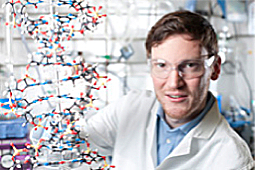 Scientists at the Imperial College London and Ludwig Maximilian University (LMU) of Munich have created a drug for type 2 diabetes that is switched on by blue light, which they hope will improve treatment of the disease. The concept is that the drug would remain inactive under normal conditions, but could be “switched-on” by the patient when necessary using blue LEDs stuck to the skin.
Scientists at the Imperial College London and Ludwig Maximilian University (LMU) of Munich have created a drug for type 2 diabetes that is switched on by blue light, which they hope will improve treatment of the disease. The concept is that the drug would remain inactive under normal conditions, but could be “switched-on” by the patient when necessary using blue LEDs stuck to the skin.
The researchers have succeeded in incorporating such an optical switch into a sulfonylurea compound; a class of synthetic drugs widely used to regulate blood glucose levels in patients with Type 2 diabetes. To help create better, more precisely tailored diabetes medicines, the ICL/LMU scientists adapted a sulfonylurea so that it changes shape when exposed to blue light. They say only a small amount of light is needed to penetrate the skin, change the drug’s shape, and turn it on. The change of activity status is reversible as well, so the drug switches off again when the light stimulation is removed.
 Diabetes drugs that promote insulin release from the pancreas can in some cases cause side effects due to their actions on other organs such as the brain and heart. Some can also stimulate too much insulin release, causing blood sugar levels to drop too low.
Diabetes drugs that promote insulin release from the pancreas can in some cases cause side effects due to their actions on other organs such as the brain and heart. Some can also stimulate too much insulin release, causing blood sugar levels to drop too low.
In a study published this week in Nature Communications, the researchers demonstrate that the prototype drug, known as JB253, stimulates insulin release from pancreatic cells in the lab when exposed to blue light.
The study was led by Dr. David Hodson and Professor and Head of Section of Cell Biology Guy Rutter from the Department of Medicine at Imperial College London, and  Professor of Chemical Biology Dirk Trauner and Dr. Johannes Broichhagenof the Trauner Research Group at LMU Munich.
Professor of Chemical Biology Dirk Trauner and Dr. Johannes Broichhagenof the Trauner Research Group at LMU Munich.
“In principle, this type of therapy may allow better control over blood sugar levels because it can be switched on for a short time when required after a meal. It should also reduce complications by targeting drug activity to where it’s needed in the pancreas,” Dr. Hodson comments. “So far, we’ve created a molecule that has the desired effect on human pancreatic cells in the lab. There’s a long way to go before a therapy is available to patients, but this remains our ultimate goal.”
The study, entitled “Optical control of insulin release using a photoswitchable sulfonylurea“ (Nat. Commun. 5:5116 doi: 10.1038/ncomms6116 (2014) is coauthored by Johannes Broichhagen, Matthias Schnberger, James A. Frank, and Dirk Trauner of the Department of Chemistry, Ludwig-Maximilians-University, and Munich Center for Integrated Protein Science at Munich; Simon C. Cork and Stefan Trapp of the Division of Biosciences, Department of Neuroscience, Physiology and Pharmacology, University College London, London; Piero Marchetti and Marco Bugliani of the Department of Clinical and Experimental Medicine, Islet Cell Laboratory, University of Pisa, Italy; A. M. James Shapiro of the Clinical Islet Laboratory and Clinical Islet transplant program at the University of Alberta, Edmonton, Alberta, Canada; and Guy A. Rutter and David J. Hodson of the Section of Cell Biology, Department of Medicine, Imperial College London, and theImperial Centre for Translational and Experimental Medicine, Hammersmith Hospital, London, UK.
The coauthors note that sulfonylureas are widely prescribed for treating type 2 diabetes mellitus (T2DM), and through their actions on ATP-sensitive potassium (KATP) channels, these drugs boost insulin release from the pancreatic beta cell mass to restore glucose homeostasis. However, a limitation of these compounds is an elevated risk of developing hypoglycemia and cardiovascular disease, both potentially fatal complications.
In this paper, they describe the design and development of a photoswitchable sulfonylurea, JB253, which reversibly and repeatedly blocks KATP channel activity following exposure to violet-blue light. Using in situ imaging and hormone assays, the researchers further show that JB253 bestows light sensitivity upon rodent and human pancreatic beta cell function. Thus, JB253 enables the optical control of insulin release and may offer a valuable research tool for the interrogation of KATP channel function in health and T2DM.
 Dr. Dirk Trauner explains in an LMU release that the basic principle behind the experimental approach as follows: “We utilize synthetic molecular switches whose structure is altered by light in conjunction with the natural receptor proteins for specific signaling molecules. The chemical switches effectively make the receptor’s function dependent on exposure to light of a certain color. Light can be controlled with exquisite precision, which allows us to target the receptor of interest with very high specificity. In addition, the activating reaction is itself reversible.”
Dr. Dirk Trauner explains in an LMU release that the basic principle behind the experimental approach as follows: “We utilize synthetic molecular switches whose structure is altered by light in conjunction with the natural receptor proteins for specific signaling molecules. The chemical switches effectively make the receptor’s function dependent on exposure to light of a certain color. Light can be controlled with exquisite precision, which allows us to target the receptor of interest with very high specificity. In addition, the activating reaction is itself reversible.”
He goes on to suggest that it should indeed be possible to control the action of any drug by means of light, a concept that opens up potential for other novel therapeutic strategies for treatment of chronic illnesses such as diabetes. Diabetes results from loss of the ability to produce or the capacity to react to insulin, which controls the uptake, metabolism and storage of glucose by cells. The hormone is secreted by the beta-cells of the pancreas when levels of glucose in the bloodstream rise, and thus serves to keep the concentration of the sugar in the circulation within narrow limits. In Type 2 diabetes, the amounts of insulin released are insufficient to compensate for reduced responsiveness to the hormone.
Hence sulfonylureas, which target ATP-sensitive potassium (K+) (KATP) channels to promote secretion of insulin, are a mainstay of diabetes therapy. However, while sulfonylureas are widely prescribed because of their effectiveness and relatively low cost, they have a range of off-target effects that limits their therapeutic use. For example, the researchers note that sulfonylureas can provoke prolonged episodes of low blood glucose due to hyperinsulinemia, elevate cardiovascular disease risk and induce weight gain.
Conversely, there is a lack of tools for the precise functional dissection of KATP channels located not only in the pancreas, but also in the brain, heart, and vascular smooth muscle. With this in mind, the research team set out to combine the glucose-lowering attributes of sulfonylureas with the exquisite spatiotemporal control conferred by possession of photoresponsive elements.
Dr. Trauner and his colleagues synthesized a light-sensitive sulfonylurea called JB253 — a fourth-generation sulfonylurea based on glimepiride that bears an azobenzene photoswitch, endowing KATP channels with remarkable photo controllable properties — and tested its ability to stimulate insulin release in laboratory experiments. They were able to show that pancreatic cells incubated with the compound secreted insulin only when exposed to blue light, which converts JB253 into a form that is recognized by its target protein, a potassium channel. Once the light is turned off, JB253 reverts to the inactive form and the effect on the potassium channel and downstream signaling pathways ceases.
The potassium channels targeted by sulfonylureas on the beta-cell surface are open when extracellular glucose levels are low. Rising levels induce uptake and metabolism of glucose, which causes the pores to close, activating insulin release, and sulfonylureas mimic this effect. “Our JB253 prototype could give us an important tool with which to dissect the function of the potassium channels,” says Dr. Trauner, who adds that he also believes photopharmacology can do more than provide novel insights for basic researchers: “We are convinced that it will also become clinically relevant in the not too distant future.”
 The idea is that light-sensitive drugs could be administered in the form of a pill, then released or activated by irradiating a patch of skin with a blue LED. When the light is switched off the drug flips back into the inactive form. “We have a long way to go before it will be possible to use such a therapy in patients. It would, however, give better control over blood sugar levels during type 2 diabetes, and would reduce the incidence of side-effects, because the active agent is released only where it is required,” says Imperial College London’s Dr. Hodson.
The idea is that light-sensitive drugs could be administered in the form of a pill, then released or activated by irradiating a patch of skin with a blue LED. When the light is switched off the drug flips back into the inactive form. “We have a long way to go before it will be possible to use such a therapy in patients. It would, however, give better control over blood sugar levels during type 2 diabetes, and would reduce the incidence of side-effects, because the active agent is released only where it is required,” says Imperial College London’s Dr. Hodson.
The next challenge will be to verify that the new compound JB253 is in fact capable of lowering blood sugar levels in animal models of Type 2 mellitus (T2DM) which is a global health-care epidemic associated with life-changing sequelae ranging from blindness to cancer. This endocrine disease, which currently affects 1 in 12 of the adult population worldwide, (around 350 million people) involves a disturbance of normal glucose homeostasis due to failure of the pancreatic beta cell mass to adequately compensate for increased peripheral insulin resistance. As such, the rescue of insulin release through the coaxing of beta cell activity remains a therapeutically desirable approach for the long-term restoration of normal glucose levels.
Type 2 diabetes affects around 350 million people worldwide. It impairs people’s control over their blood sugar levels, leading to higher risk of heart disease and stroke and potentially causing damage to the kidneys, nerves and retinas.
Although molecules that react to light have been known about since the 19th century, only in the last few years have scientists exploited their properties to make light-sensitive molecules with drug effects.
 “Photoswitchable drugs and photopharmacology could be enormously useful for all sorts of diseases, by allowing remote control over specific body processes with light,” says Professor Trauner in an Imperial College London release.
“Photoswitchable drugs and photopharmacology could be enormously useful for all sorts of diseases, by allowing remote control over specific body processes with light,” says Professor Trauner in an Imperial College London release.
The research was funded by Diabetes UK, the European Foundation for the Study of Diabetes, the European Research Council, the Wellcome Trust and the Medical Research Council.
Dr Richard Elliott, from Diabetes UK, says: “Sulfonylureas help many people to manage type 2 diabetes even though, like other medications, they can have side effects. Work on light-activated medications is still at a relatively early stage, but this is nevertheless a fascinating area of study that, with further research, could help to produce a safer, more tightly-controllable version of this important therapy.”
Sources:
Imperial College London
Nature Communications
Ludwig Maximilian University of Munich
Image Credits:
Imperial College London
Nature Communications


